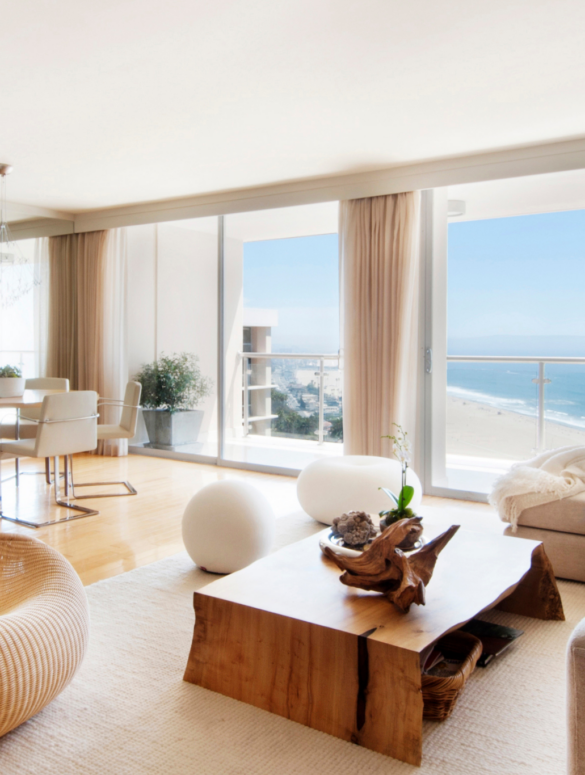Text by Laura Bolt
Images courtesy of Sarah Barnard
Los Angeles interior designer Sarah Barnard might just be at the forefront of revolutionizing the way we live from the inside out.
As a LEED and WELL certified designer, and founder of the boutique firm Sarah Barnard Design, Barnard has been crafting eco-friendly interiors and sustainable spaces that aim to promote mental, physical, and emotional wellbeing since 2003. From beach front cottages to sprawling office buildings, her work has caught the attention of VOGUE, Elle Decor, and Architectural Digest, and has won accolades like the American Society of Interior Designers Ones to Watch Award and the 2022 Best of Houzz Design. With sustainability gaining steam in the design sphere and beyond, Barnard is ready to take on the challenge of designing for a changing world, one room at a time.
Growing up in Los Angeles with historic preservationist parents gave Barnard a unique perspective on taking advantage of the world around you. There’s a popular saying amongst historic preservationists that “the greenest building is one that has already been built,” an axiom that Barnard’s father took to heart. Barnard would often come back to treasures her father found while scouring the neighborhood for homes that were set to be demolished, like an old set of windows or other architectural dealings.

“Everything was repurposed or DIY,” she remembers. “Over time it taught me the practical side of sustainability and gave me a natural reflex to use what I had and respect my surroundings.”
Barnard’s inclination to cultivate interiors by bringing the natural world in follows a long lineage of Los Angeles design history. While cities like New York signified modernity by building ever higher into the sky, Los Angeles set itself apart in the world of modern architecture by fostering a symbiotic relationship between architecture and the natural world.
Inspired by California’s mild weather, year-round sunshine, and wild landscape, architects like Irving Gill, Frank Lloyd Wright, and Richard Neutra were drawn to the west coast to build homes that celebrated nature, health, and living in harmony with the surroundings.


In her book “California Design 1930–1965: Living in a Modern Way” Wendy Kaplan refers to California’s “benign climate that permitted the great outdoors to be incorporated as an extended living room…California modernism became a different, and hugely influential, model for the rest of the country and was widely admired abroad because it reflected the way people really wanted to live.”
Reflecting the way people really want to live is at the heart of Barnard’s work as a designer. She regards her creative modality as “conscious design,” which refers to both her work as a champion of sustainability, as well as an advocate for self-awareness in exploring what you really need out of your home. According to her, “being able to facilitate folks making choices for their homes that feel good or right for them is a big, big part of my practice. I need to meet you where you are so I can plan your space to support your real life.”
In the vital but sometimes hypercritical world of green design, Barnard’s approach is refreshingly down to earth.
“One thing that I experience is that sometimes clients want to make sustainable decisions, but they’re concerned that their interior designer might judge them if they aren’t doing it perfectly,” she notes. “They don’t want to disclose that they actually eat pizza every Sunday, or smoke an occasional cigarette. But my job is not only to show you sustainable options you didn’t know existed, like vegan options, non-toxic finishes, or responsible manufacturing, it’s also to create a safe space to support whatever your life looks like now, and wherever it’s trying to go.”

Aligning our lives with nature is a really excellent free and instant upgrade we can all make.
Sarah Barnard
Recently, she has been finding a sort of zen in the art of limitations. With people spending more time at home, her work as an interior designer has become more complex and multifaceted than ever before as she juggles the demands of making her client’s living spaces serve as everything from office space, to restaurant, to private gym. Her approach to this challenge is ever evolving, as she works to cultivate patience in her practice.
“It’s time to move away from hinging our present happiness on something that even with the best, most organized plan and intentions, the universe may not be able to deliver as a reality for six months or a year,” she says. “So I try to encourage clients to think about their daily experience and ask them questions like, ‘What are the ways that we can reduce clutter? What are ways that we can infuse joy or brightness into spaces that are becoming monotonous because we simply haven’t left them frequently enough?’ And aligning our lives with nature is a really excellent free and instant upgrade we can all make.”


These days, Barnard finds inspiration in simple, organic moments like time in her garden (currently living in a home that’s adjacent to woodland, she still delights in the deer that come visit and “decimate her roses,” to the surprise of her more jaded neighbors).
With an increasing focus on sustainability in the world of interiors and beyond, she believes that the future of design will rely on the growth of responsibly sourced and sustainable materials.
For her part, she collaborated with Kale Tree fabrics in 2021 to represent their new Tradescant & Son line of eco-friendly fabrics, adorned with birds, moths, and beetles inspired by the entomology archives of the University of Oxford Museum of Natural History.
Ultimately, she believes that a movement to create consciousness around our living spaces could spark something that extends beyond the confines of your home. Speaking of this consciousness revival, Barnard ruminates on the kind of society where “every human gets a house and a small plot of land. Imagine what creatures we would be if the basic struggles of housing, access to nature, and the ability to grow your own food were all solved. What amazing things would we do?”
Maybe if we all took Sarah’s brand of care towards ourselves and our spaces to heart, we could come a little closer to finding out.


